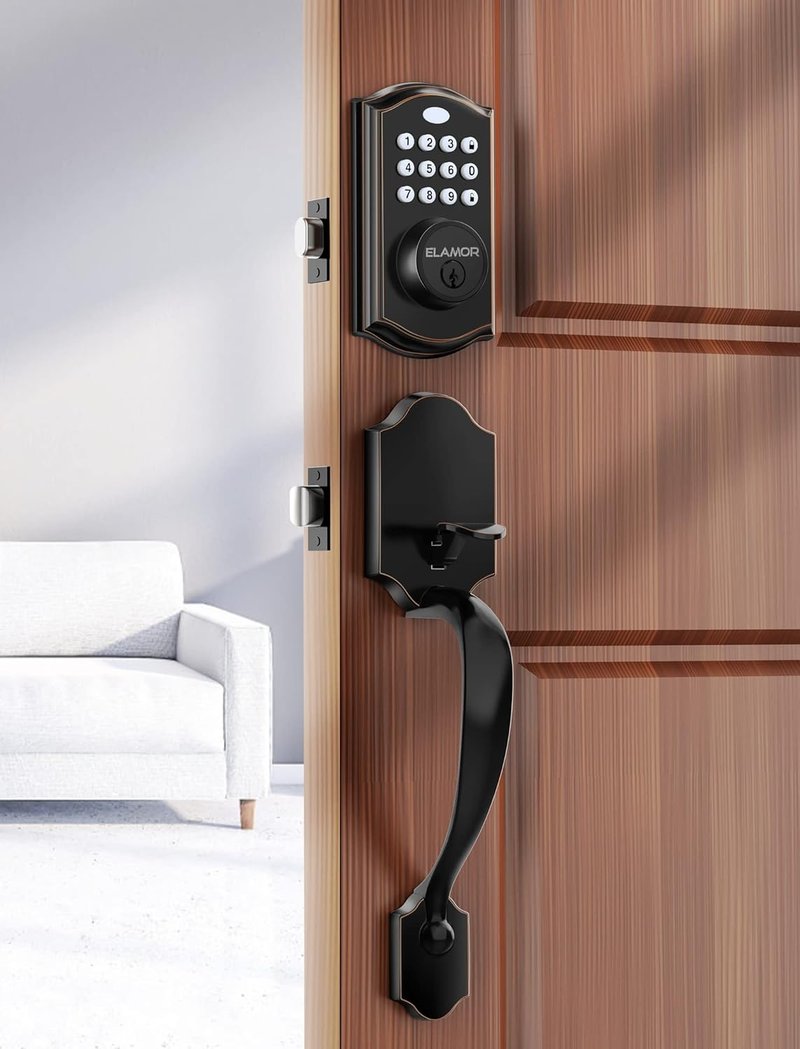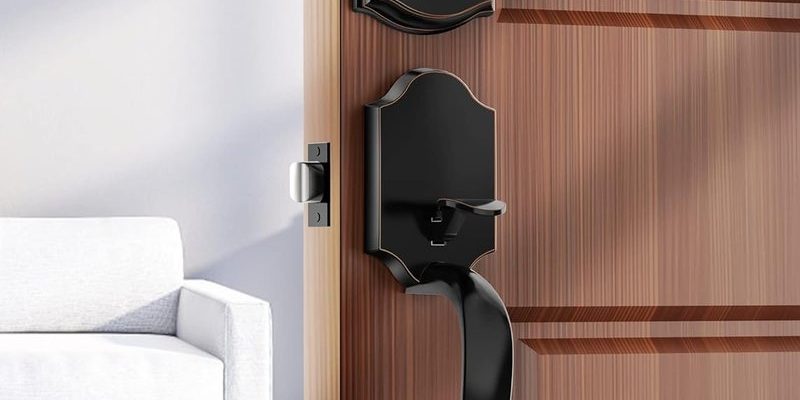
Think of it like swapping your old flip phone for a smartphone: you still call people, but suddenly you can do a whole lot more. A smart deadbolt replaces the old brass-and-tumbler setup with sleek, digital power. No more worrying about lost keys. You get remote access, easy code sharing for guests, and instant lock/unlock from anywhere (as long as your lock is connected).
If you’re new to installing door hardware, don’t stress. You don’t need to be a pro, and there’s no shame in double-checking a screw or two. Let’s walk through the whole process—no skipped steps, no fancy jargon.
What Is a Keyless Entry Deadbolt and Why Upgrade?
You might be wondering, “What makes a keyless entry deadbolt so different?” Here’s the thing: traditional deadbolts use a key. Lose the key, and you’re stuck. With a smart deadbolt, doors unlock with a code, a smartphone app, or sometimes a fingerprint. That means you control access without ever handing out a key—perfect for pet sitters, Airbnb guests, or forgetful teens.
Smart deadbolts, like the Schlage Encode or August Smart Lock, also bring remote access into the mix. That’s a game-changer if you travel, have deliveries, or just want to check if you locked up. Many models can even pair with your Wi-Fi or smart home system, so you can lock or unlock from anywhere and get alerts if something’s off.
Honestly, once you get used to entering a code or tapping “lock” on your phone, fumbling with keys feels ancient. On top of that, smart locks often keep a log of who comes and goes. That’s handy if you want to keep tabs on kids, cleaners, or guests.
Choosing the Right Smart Deadbolt for Your Door
Picking a keyless entry deadbolt isn’t a one-size-fits-all thing. First, check your door. Most smart locks need a standard deadbolt hole—usually 2 1/8″, which is pretty common in US homes. If your house is older, measure first. Some smart deadbolts, like August, can retrofit over existing deadbolts, while others completely replace your lock.
Next, think about how you want to unlock the door:
- Touchscreen keypads (like the Yale Assure SL) let you enter codes. No keys needed—just remember the numbers.
- Smartphone app locks (like August or Schlage Encode) use Bluetooth, Wi-Fi, or both. You can unlock from afar if you have remote access set up.
- Biometric locks add fingerprint scanning. Not every brand offers this, but it’s super fast.
Make sure the deadbolt you choose works with your smart home setup. For example, if you use Alexa or Google Home, double-check compatibility before you buy. Some locks need a separate hub to connect, while others have Wi-Fi built in.
Gathering Tools and Prepping Your Door
Before you start, get everything ready. Most smart deadbolt kits (like those from Schlage, Kwikset, and Yale) come with what you need, but you’ll want a few tools on hand:
- Phillips-head screwdriver
- Flat-head screwdriver (less common, but sometimes needed)
- Tape measure
- Drill (for rare cases when you need to widen the hole, but usually not required)
- Batteries (usually AA or AAA, not always included in the box)
Here’s a tip: take a photo of your current deadbolt (both sides) before you remove anything. It’s a lifesaver if you need to backtrack. Make sure your door opens and closes smoothly—smart deadbolts don’t love sticky frames.
Remove your old deadbolt by unscrewing and sliding out both the inside and outside pieces. Clear any dust or debris from the holes. Lay out your new smart deadbolt pieces; most big brands color-code or label them to make things easy.
Step-by-Step: Installing a Keyless Entry Deadbolt
Okay, here’s where you actually get hands-on. I’ll run you through the steps for a typical installation—say, a Yale Assure SL or Schlage Encode. Each model’s a bit different, so always glance at your instructions, but this should cover the basics.
- Insert the deadbolt latch. Slide the new latch into the door’s edge where the old one was. Make sure the “up” label faces the right way. Use the included screws to secure it—snug, but not overtightened.
- Attach the exterior keypad. Place the touchscreen or keypad on the outside of your door, threading any cables (if present) through the hole to the inside.
- Connect the interior plate/housing. Inside, attach the matching plate. If your lock has a cable, gently plug it into the designated slot (this is where “code” and “sync” can enter the picture—don’t force anything). Hold both halves together and add the screws to secure them.
- Insert the batteries. Open the battery compartment—usually a sliding or lifting cover. Insert new batteries in the correct direction. Replace the cover.
- Test the lock. With the door open, run the lock through a few cycles. Try locking and unlocking via keypad. If it’s a smart lock, start the pairing or sync process using the manufacturer’s app.
If anything feels stuck or the lock doesn’t actuate smoothly, *double-check that the latch is lined up and the deadbolt isn’t rubbing the frame*. Sometimes a little adjustment makes all the difference.
Pairing and Syncing With Your Smart Home System
So, the hardware is up. Now it’s time to connect your smart deadbolt to your Wi-Fi or home automation setup. This step unlocks the real magic—remote locking, code sharing, even voice control (if you want to yell “lock the door” at your smart speaker while making dinner).
Download the brand’s app (like Yale Access or Schlage Home). Most apps will guide you through the steps:
- Put the lock in “pair” mode. There’s usually a button to press or a code to enter on the keypad.
- Open the app and hit “add device.”
- Follow prompts to connect to your Wi-Fi or hub. You might need to scan a QR code inside the battery compartment.
- Name your lock and set a master code or admin account.
Be patient—syncing can take a minute or two. If you run into trouble, these apps usually have a “reset” or “factory default” option to start over. Check that your phone’s Bluetooth and Wi-Fi are turned on. Sometimes you’ll need to enter a unique code that comes with the lock.
Pro tip: Always test locking and unlocking both from the app and the keypad before closing the door. You don’t want to lock yourself out while troubleshooting.
Setting Codes, Managing Access, and Everyday Use
Here’s where smart deadbolts really shine. Instead of wrestling with keys, you tap in a code or unlock the door from your phone—even if you’re still in bed or halfway across town. Each model is a little different, but most let you do these things from the app or keypad:
- Set a master code. This is your main access code. Don’t make it something like “1234”—get a bit creative.
- Add user codes. Give friends, family, or renters their own codes. Set them to expire or work only at certain times if you want.
- Enable auto-lock/auto-unlock. Some locks can automatically lock behind you, or unlock as you approach (like August’s geofencing feature).
- Check access logs. See who’s come and gone. Some apps show dates, times, and even failed code attempts.
If you need to change codes, just hop into the app or follow the lock’s built-in instructions—no need for locksmiths or hardware changes. Most brands let you manage codes from anywhere with internet access.
Troubleshooting Common Installation and Connection Issues
Let me be real: sometimes technology throws a wrench in even the best plans. If your keyless deadbolt isn’t working as expected, start with these common fixes.
- Batteries dead? If the lock stops working or beeps oddly, check the battery. Most locks flash or chirp when batteries run low. Pop in a new set (all at once).
- Keypad not responding? Try a “reset” (usually holding a button inside the battery compartment). Re-sync the lock to your app if you’re having pairing issues.
- Deadbolt stuck? Double-check that the latch is lined up, and the door isn’t sagging. A misaligned strike plate can block the lock.
- App can’t find the lock? Make sure Bluetooth and Wi-Fi are both enabled—and you’re close enough for initial pairing. Sometimes routers need a restart if devices won’t sync.
If none of this works, the manufacturer’s website usually has code-specific troubleshooting steps. Don’t be shy about calling or chatting with support—they’re used to helping beginners get things running.
Comparing Smart Deadbolts: Which Type Fits Your Life?
You might be torn between a full-on smart deadbolt replacement or a simple retrofit. Let me break down the main types:
- Complete replacements (like Schlage Encode, Yale Assure SL): These swap out your entire deadbolt for a new, connected one. Best if you want all the features (touchscreen, app, full remote).
- Retrofit smart locks (like August Wi-Fi Smart Lock): These fit over your existing deadbolt hardware, so you keep your old keys as a backup. Great for apartments or if you don’t want to change your current lock style.
- Wi-Fi vs. Bluetooth: Wi-Fi models let you control your lock from anywhere, while Bluetooth-only locks usually require you to be close by. Some require an extra “hub” to connect to your network—double-check what’s included in the box.
Consider your needs. If you want true remote access, go Wi-Fi. If you’re renting or need a lower-commitment option, a retrofit might be perfect. Honestly, both are easy enough for DIY installation, so it’s about your style and smart home setup.
Keeping Your Smart Lock Secure and Up-To-Date
Now that your lock is up and running, a little regular care goes a long way. First, update your lock’s firmware through the app whenever a new version drops. Think of these updates like a free security upgrade—patching bugs or improving features.
Change your access codes every so often, especially if you’ve given out temporary codes for guests or services. If your lock ever acts odd (like locking/unlocking on its own, or not appearing in your app), check for a software reset option. It’s the “turn it off and on again” trick for the smart home age.
Keep spare batteries in a drawer near the door. If your lock runs out of power, most models have a physical key backup or a hidden charging terminal (sometimes under the keypad). Don’t forget to use a strong Wi-Fi password and enable any multi-factor authentication offered by your lock’s app.
Insight: Just like with any smart device, the security of your keyless entry deadbolt is only as good as your habits. Regularly check for updates and keep your codes private.
Final Thoughts: Enjoying Your Keyless Entry Deadbolt
Taking the leap to a smart home lock isn’t just about tech—it’s about making life easier. Once you get used to unlocking your door with a quick code or a tap on your phone, you’ll wonder why you waited so long. All the little headaches—lost keys, lockouts, juggling spares for guests—just disappear.
Remember, no matter which smart deadbolt you choose, the basics are the same: measure your door, grab the right tools, and follow the included steps slowly. Sync with your app, test everything before shutting the door, and make use of those nifty features like access logs and auto-lock.
If you hit a snag, don’t panic—most setup hiccups are fixable, and the payoff is totally worth it. Before long, you’ll unlock your front door the smart way: no keys, no hassles, just a touch of modern convenience every time you come home.
